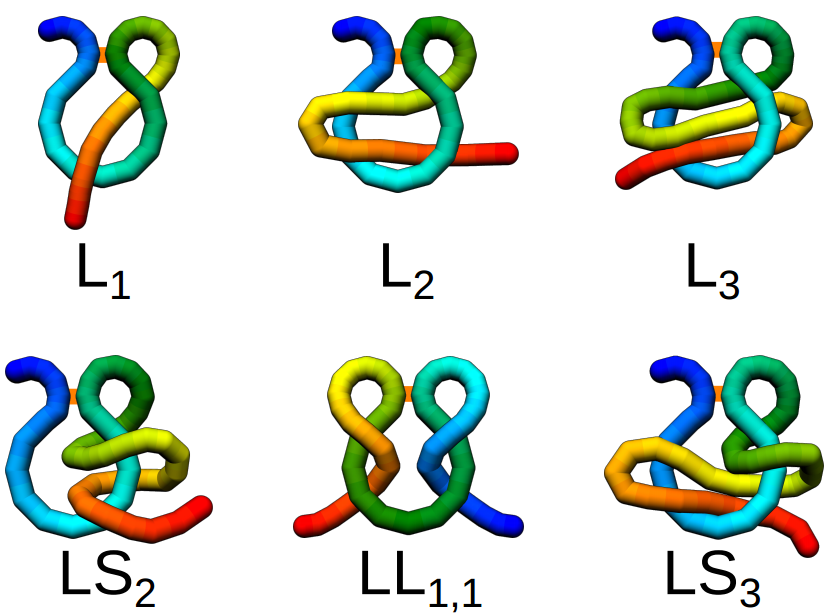Complex Lasso Proteins on:
[Wikipedia]
[Google]
[Amazon]
Complex lasso proteins (also called pierced lasso bundles or tadpoles) are proteins in which a covalent loop (portion of the backbone closed with a covalent bridge) is pierced by another piece of the backbone. Subclass of complex lasso proteins are Lasso peptides in which the loop is formed by post-translational
 Complex lassos can be divided according to the number of piercings through the
Complex lassos can be divided according to the number of piercings through the
LassoProt
database, which allows also uploading and analyzing own data. The manual inspection of the data is also possible with th
PyLasso
ref> - the PyMol plugin.
amide
In organic chemistry, an amide, also known as an organic amide or a carboxamide, is a compound with the general formula , where R, R', and R″ represent organic groups or hydrogen atoms. The amide group is called a peptide bond when it i ...
bridge.
Classification of complex lassos
 Complex lassos can be divided according to the number of piercings through the
Complex lassos can be divided according to the number of piercings through the minimal surface
In mathematics, a minimal surface is a surface that locally minimizes its area. This is equivalent to having zero mean curvature (see definitions below).
The term "minimal surface" is used because these surfaces originally arose as surfaces tha ...
spanned on the covalent loop. In particular, four classes of complex lasso proteins exist:
* the Ln class (simple lasso), where one tail pierces the surface n times;
* the LSn class (the supercoiling lasso), where one tail pierces the surface n times, winding around the loop;
* the LLi,j class (double lasso), where both tails pierce the surface i and j times respectively;
* the LSLi,j class, where one tail pierces the surface i times in the supercoiling manner, and the second pierces the surface in the simple manner.
Another classification may be given according to the nature of the bridge closing the covalent loop. Most of the complex lasso proteins have a disulfide-based loop, however, the amide-based ( lasso peptides) and ester-based complex lasso proteins are known.
Popularity of complex lasso in proteins
Around 18% of proteins withdisulfide
In biochemistry, a disulfide (or disulphide in British English) refers to a functional group with the structure . The linkage is also called an SS-bond or sometimes a disulfide bridge and is usually derived by the coupling of two thiol groups. In ...
bridges have complex lasso, however, much more complex lasso would be predicted when analyzing the non-interacting polymeric models. Apart from structures with only one pierced loop, there may be also chains with several complex lasso structures. In particular, the loops may pierce each other, forming a protein Hopf link
In mathematical knot theory, the Hopf link is the simplest nontrivial link with more than one component. It consists of two circles linked together exactly once, and is named after Heinz Hopf.
Geometric realization
A concrete model consists o ...
. There are much less complex lassos in proteins than it is expected from simple polymer models. However, there are groups of proteins which have higher complex lasso probability than we could expect from such models.
Biological role
It is not known if the complex lasso motif is functional in general. However, in some cases the importance of the motif for the protein function was reported. In particular, in case of lasso peptides, the motif allows to act like a plug for specific NTP-uptake channels. On the other hand, the motif was shown to be functional in case of leptin - the obesity-related protein. The analysis of the shape of complex lasso proteins compared to the polymeric models with similar size shows, that some classes of complex lasso proteins may also be functional. This concerns toxic, antimicrobial, defensin-like or immune system related with L1 motifComputer tools to analyze the complex lasso topology
The current list of complex lasso proteins may be found in thLassoProt
database, which allows also uploading and analyzing own data. The manual inspection of the data is also possible with th
PyLasso
ref> - the PyMol plugin.
See also
Knotted proteinsReferences
{{reflist Peptides Biosynthesis